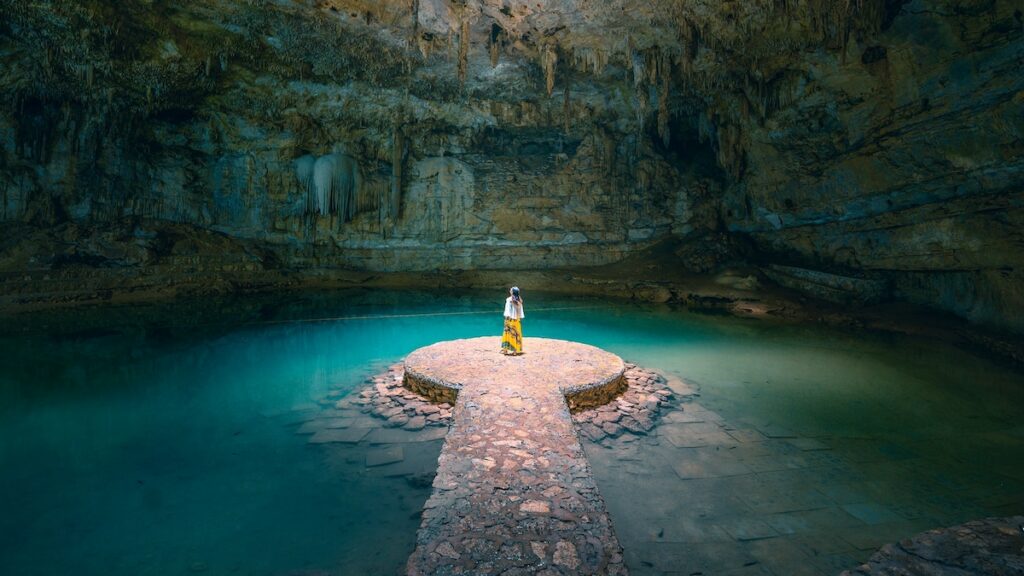Caves have been central to the human experience, whether as early forms of shelter or as sacred religious sites. But eventually humans crawled out, stood up, looked around, and realized the outside world held more creature comforts. Lately, wellness caves have travelers heading back underground seeking darkness, quiet, solitude, and perhaps even spiritual enlightenment.
These subterranean escapes can be rustic or luxuriously stylish. Some, like the Sky Cave Retreats in Oregon or the Dark Retreat Earth Domes in Thailand, are man-made, carved into the ground, or constructed by piling earth upon stone. Others were formed naturally, like the famous Dungeshwari Cave near Bodh Gaya in India’s Bihar state, where a young Buddha allegedly took shelter. While caves were once seen as a last resort, now they’re often used for recreational purposes, like yoga classes, sound baths, or meditation. What ties these spaces together is a sense of retreating, reflection, and resetting.
Caves as sacred and social sites
Religious and social groups have long gathered in caves. In Central America, Maya people went to caves to leave offerings for gods, consume mind-altering substances, and, sometimes, make human sacrifices. Tibetan Buddhist “dark retreats,” which last from three to 49 days, involve advanced practitioners sitting in caves, meditating on their mortality. Christians in ancient Greece and Rome likely used their vast maze of catacombs for private worship and to escape prosecution.
(Inside the Irish “hell caves” where Halloween was born.)
Travelers probably won’t commit to spending weeks underground. But those hiking Dochula Pass in Bhutan can take a side trail to tiny, open-faced meditation caves and spend a few quiet minutes reflecting on the green forests and rugged mountains. A 20-minute drive from Tulsa, Oklahoma, the Forest of Peace retreat invites visitors into its “Cave of the Mothers,” a storm shelter converted into a meditation space.
“There is a curiosity about sensory deprivation practices that can alert us to something greater in ourselves,” says Tim McHenry, chief programming officer at New York City’s Rubin Museum of Art, a Himalayan culture center that has hosted dark meditation in one of its cavelike spaces. “It is so rare that we experience being in the utter dark.”
In Oregon, Sky Cave Retreats offer soundproof, underground rooms built into a hillside that are accessed via a ladder from an opening at the top.
Photograph by SkyCave Retreats
Caves to cure what ails you
Spending time in the dark might be good for your health, too. “In the 1960s, scientists began looking into REST [Restricted Environmental Stimulation Therapy],” says Scott Berman, the founder of Oregon’s Sky Cave Retreats. “They started to find that it was really beneficial for soothing the nervous system and for relaxation.”
Research finds that spending time in pitch black can be particularly helpful for specific mental health issues or vision problems. Since its popularization in the 1960s (largely credited to German anthropologist Holger Kalweit), darkness therapy has been successfully used to treat symptoms of bipolar disorder, chronic fatigue syndrome, and migraines. More recent studies have seen positive effects for people with amblyopia (aka “lazy eye”).
That’s led to dozens of dark retreat centers opening across Europe. Now the therapy is catching on in North America, thanks in part to the high-profile endorsements of NFL player Aaron Rodgers and actress Rosario Dawson. For professional athletes and creatives, darkness retreats can provide a much-needed escape from the hum and chatter of public life. “Sitting on that couch all day or scrolling on your phone, that is death,” said Dawson after completing her four days at Sky Cave. “This retreat made me recognize that I need to have such a deeper loving relationship with my body.”
“The underground teaches us to respect mystery,” argues author Will Hunt in his 2019 book, Underground: A Human History of the Worlds Beneath Our Feet. According to Hunt, his excursions into subway tunnels, catacombs, and caverns led to the realization that “not everything should be revealed, not all the time.”
(This Slovenian cave is a real “house of dragons.”)
How to take a cave retreat
At Sky Cave Retreats, visitors stay overnight (or for weeks) in 300-square-foot underground suites built into the hillside from concrete blocks and metal rebar, furnished with beds, floor pillows, rugs, and wood-burning stoves. These “caves” are warm, lightproof, and soundproof. “That’s something many people don’t expect, that there will be no noise,” says Berman. “It gives people a visceral experience of timelessness. You enter into an unchanging reality.” Staff are on hand to deliver meals (which are consumed in darkness) and each suite is equipped with a private bathroom, a flushing toilet, and a bathtub for quiet, hot soaks.
Samaya Meditation Center in Indonesia offers a similar set-up, encouraging practitioners to book three full days in their simple yet cozy dark room. Plant-based meals are provided, and while the rooms aren’t quite soundproof, each guest is given earplugs upon arrival.
Of course, one need not commit several days in order to feel some inner shift. It’s possible to visit an Himalayan salt cave for an hour or rent a room carved into the side of the Tres Cuevas Mountain via Summit at Big Bend, in Texas. A group session of cave yoga at Olentangy Caverns in Ohio provides an active way to enjoy the underground, and many parks offer private, guided cave tours. Whether for an hour or a month, visitors will now find a variety of ways to dabble in darkness.
(The land of the Sleeping Beauty Cave is waking up to tourism.)
>>> Read full article>>>
Copyright for syndicated content belongs to the linked Source : National Geographic – https://www.nationalgeographic.com/travel/article/wellness-cave-trips-dark-therapy
